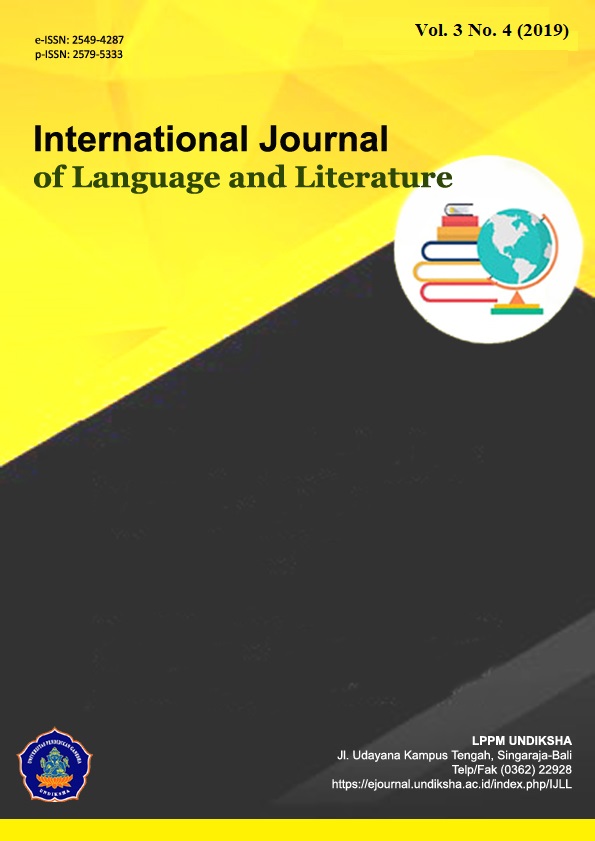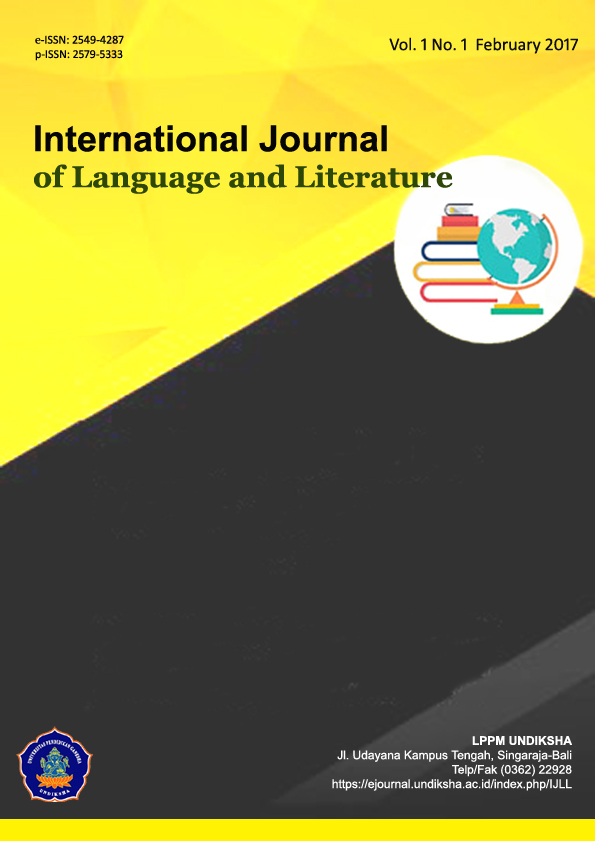DEVELOPING STORY JUMPER-BASED TEACHING MEDIA TO ENRICH KINDERGARTEN STUDENTS’ VOCABULARY
DOI:
https://doi.org/10.23887/ijll.v3i4.28415Keywords:
ADDIE model, story jumper-based teaching media, young learnersAbstract
The demand of integrating technology in instruction is essential since today’s learning became Education 4.0. Thus, teachers are in need of help in creating suitable media to be implemented. This research aimed to know the development of story jumper to enrich kindergarten students’ vocabulary and to know its quality. This research was Design and Development Research implementing ADDIE model. The subject of this research were three teachers and three kindergarten students. To know the quality, classroom observation, post-implementation questionnaire, and an interview were administered. The result showed, the media are good in helping the teachers deliver the material, and it is very easy to use. The students admitted that the media were able to attract their attention. The media produced are good enough to be used in further implementation. Teachers could refer to Story Jumper because of its practicality and benefits in helping them achieving the learning outcomes.References
Aldoobie, N. (2015). ADDIE Model. American International Journal of Contemporary Research, 5(6), 68–72.
Amos, P. M., Adu, J., & Antwi, T. (2017). The Use Of Instructional Materials At The Kindergarten Level To Help Children Own Their Own Knowledge. Journal of Advances in Social Science and Humanities.
Blackwell, C. (2014). Teaher Practices with Mobile Technology Integrating Tablet Computers into the Early Childhood Classroom. Journal of Education Research, 7(4), 1–25.
Bonin, G. (n.d.). 9 Basic Steps: Teaching Storytelling to Students.
Damavandi, Z. M., Hassaskhah, J., & Zafarghandi, A. M. (2018). The Effects of Computer Assisted Mediating Prompts on EFL Learners’ Writing Ability. International Journal of Education and Literacy Studies, 6(1), 64–71. https://doi.org/10.7575/aiac.ijels.v.6n.1p.64
Fatimah, A. S. (2017). Teaching in 21st Century: Students-Teachers’ Perceptions of Technology Use in the Classroom. Script Journal: Journal of Linguistic and English Teaching, 2(2), 125–135. https://doi.org/10.24903/sj.v2i2.132
Ghavifekr, S., & Rosdy, W. A. W. (2015). Teaching and Learning with Technology: Effectiveness of ICT Integration in Schools. International Journal of Research in Education and Science (IJRES), 1(2), 175–191. https://doi.org/10.21890/ijres.23596
Habibu, T., Abdullah-Al-Mamun, M., & Clement, C. (2020). Difficulties Faced by Teachers in Using ICT in Teaching-Learning at Technical and Higher Educational Institutions of Uganda. International Journal of Engineering Reserach & Technology (IJERT), 1(7), 1–10.
Howard, S. K., & Mozejko, A. (2015). Teachers: technology, change and resistance. In Teaching and Digital Technologies: Big Issues and Critical Questions (pp. 307–317).
Hussin, A. A. (2018). Education 4 . 0 Made Simple: Ideas for Teaching. International Journal of Education and Literacy Studies, 6(3), 92–98.
Juma, W. E. (2016). Utilization of Instructional Media To Enhance Students’ Learning of English in Bungoma North District’s Secondary Schools, Bungoma County, Kenya. Kenyatta University.
Leteane, O., Pholele, T. M., Moakofhi, M., & Phiri, T. (2015). Usage , Challenges and Perceptions of ICT by Teachers in Junior Secondary Schools in Botswana.
Parvin, R. H., & Salam, S. F. (2015). The Effectiveness of Using Technology in English Language Classrooms in Government Primary Schools in Bangladesh. FIRE: Forum for International Research in Education, 2(1), 47–59. https://doi.org/10.18275/fire201502011049
Richey, R. C., & Klein, J. D. (2016). Design and Development Research (1st Edition). Routledge.
Robin, B. R. (2006). Educational Uses of Digital Storytelling. Retrieved from http://digitalstorytelling.coe.uh.edu/page.cfm?id=27
Romiszowski, A. J. (1984). Designing Instructional Systems. Nichols Pub Co.
Salazar, G. U., & Larenas, C. D. (2018). Using an Audiovisual Materials-Based Teaching Strategy to Improve EFL Young Learners’ Understanding of Instructions. How, 25(2), 91–112. https://doi.org/10.19183/how.25.2.419
Sandström, C., & Kindenberg, B. (2016). Working with Story Jumper.
Shahroom, A. A., & Hussin, N. (2018). Industrial Revolution 4.0 and Education. International Journal of Academic Research in Business and Social Sciences, 8(9), 314–319. https://doi.org/10.6007/ijarbss/v8-i9/4593
Tegeh, I. M., Jampel, I. N., & Pudjawan, K. (2015). Pengembangan Buku Ajar Model Penelitian Pengembangan dengan Model ADDIE. In Seminar Nasional Riset Inovatif IV (pp. 208–216).
Zomer, N. R., & Kay, R. H. (2016). Technology Use in Early Childhood Education: A Review of the Literature. Journal of Educational Informatics, 1, 1–25.
Downloads
Published
How to Cite
Issue
Section
License
IJLL Journal provides immediate open access to its content on the principle that making research freely available to the public to supports a greater global exchange of knowledge.

This work is licensed under a Creative Commons Attribution-ShareAlike 4.0 International License








